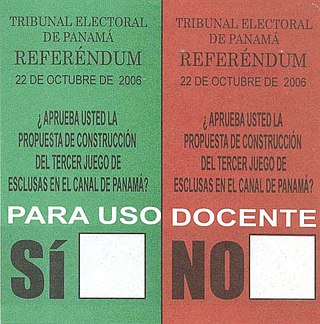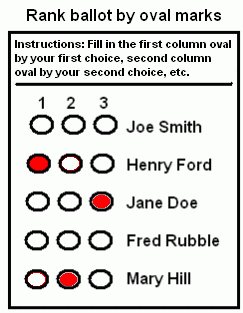
Proportional representation (PR) refers to any type of electoral system under which subgroups of an electorate are reflected proportionately in the elected body. The concept applies mainly to political divisions among voters. The essence of such systems is that all votes cast – or almost all votes cast – contribute to the result and are effectively used to help elect someone – not just a bare plurality or (exclusively) the majority – and that the system produces mixed, balanced representation reflecting how votes are cast.

The single transferable vote (STV), sometimes known as proportional ranked choice voting (P-RCV), is a multi-winner electoral system in which each voter casts a single vote in the form of a ranked-choice ballot. Voters have the option to rank candidates, and their vote may be transferred according to alternate preferences if their preferred candidate is eliminated or elected with surplus votes, so that their vote is used to elect someone they prefer over others in the running. STV aims to approach proportional representation based on votes cast in the district where it is used, so that each vote is worth about the same as another. Formally, STV satisfies a fairness criterion known as proportionality for solid coalitions.

A Condorcet method is an election method that elects the candidate who wins a majority of the vote in every head-to-head election against each of the other candidates, whenever there is such a candidate. A candidate with this property, the pairwise champion or beats-all winner, is formally called the Condorcet winner. The head-to-head elections need not be done separately; a voter's choice within any given pair can be determined from the ranking.

Voting is a method by which a group, such as a meeting or an electorate, convenes together for the purpose of making a collective decision or expressing an opinion usually following discussions, debates or election campaigns. Democracies elect holders of high office by voting. Residents of a jurisdiction represented by an elected official are called "constituents", and the constituents who choose to cast a ballot for their chosen candidate are called "voters." There are different systems for collecting votes, but while many of the systems used in decision-making can also be used as electoral systems, any which cater to proportional representation can only be used in elections.
In the study of electoral systems, the Droop quota is the minimum number of votes needed for a party or candidate to guarantee themselves one extra seat in a legislature. It generalizes the concept of a majority to multiple-winner elections: just as a majority guarantees a candidate can be declared the winner of a one-on-one election, having more than one Droop quota's worth of votes measures the number of votes a candidate needs to be guaranteed victory in a multiwinner election.

Copeland's method, also called Llull's method or round-robin voting, is a ranked-choice voting system based on scoring pairwise wins and losses.
Ranked pairs, sometimes called the Tideman method, is a tournament-style system of ranked-choice voting first proposed by Nicolaus Tideman in 1987.
The Imperiali quota is a formula used to calculate the minimum number, or quota, of votes required to capture a seat in some forms of single transferable vote or largest remainder method party-list proportional representation voting systems. It is distinct from the Imperiali method, a type of highest average method. It is named after Belgian senator Pierre Imperiali.
In the study of apportionment, the Harequota is the number of voters represented by each legislator under a system of proportional representation. In these voting systems, the quota is the number of votes that guarantees a candidate, or a party in some cases, captures a seat. The Hare quota is the total number of votes divided by the number of seats to be filled.
In an election, a candidate is called a Condorcet, beats-all, or majority-rule winner if more than half of voters would support them in any one-on-one matchup with another candidate. Such a candidate is also called an undefeated, or tournament champion, by analogy with round-robin tournaments. Voting systems where a majority-rule winner will always win the election are said to satisfy the Condorcetcriterion. Condorcet voting methods extend majority rule to elections with more than one candidate.
The single transferable vote (STV) is a proportional representation voting system that elects multiple winners. It is one of several ways of choosing winners from ballots that rank candidates by preference. Under STV, an elector's vote is initially allocated to their most-preferred candidate. Candidates are elected (winners) if their vote tally reaches quota. After this 1st Count, if seats still remain open, surplus votes are transferred from winners to remaining candidates (hopefuls) according to the surplus ballots' next usable back-up preference. if no surplus votes have to be transferred, then the least-popular candidate is eliminated so the vote has chance to be placed on a candidate who can use it.
The Edmonton provincial electoral district also known as Edmonton City from 1905 to 1909, was a provincial electoral district in Alberta, Canada mandated to return members to the Legislative Assembly of Alberta from 1905 to 1917 and again from 1921 to 1959.
The later-no-harm criterion is a voting system criterion first formulated by Douglas Woodall. Woodall defined the criterion by saying that "[a]dding a later preference to a ballot should not harm any candidate already listed." For example, a ranked voting method in which a voter adding a 3rd preference could reduce the likelihood of their 1st preference being selected, fails later-no-harm.
There are a number of complications and issues surrounding the application and use of single transferable vote proportional representation that form the basis of discussions between its advocates and detractors.
Schulze STV is a draft single transferable vote (STV) ranked voting system designed to achieve proportional representation. It was invented by Markus Schulze, who developed the Schulze method for resolving ties using a Condorcet method. Schulze STV is similar to CPO-STV in that it compares possible winning candidate pairs and selects the Condorcet winner. It is not used in parliamentary elections.
Instant-runoff voting (IRV), also known as plurality with elimination or plurality loser, is a ranked-choice voting system that modifies plurality by repeatedly eliminating the last-place winner until only one candidate is left. In the United Kingdom, it is generally called the alternative vote (AV). In the United States, IRV is often referred to as ranked-choice voting (RCV), by way of conflation with ranked voting systems in general; however, this use is not widespread outside of North America or among election scientists.
In elections that use the single transferable vote (STV) method, quotas are used (a) for the determination of candidates considered elected; and (b) for the calculation of surplus votes to be redistributed. Two quotas in common use are the Hare quota and the Droop quota. The largest remainder method of party-list proportional representation can also use Hare quotas or Droop quotas.

An electoral system or voting system is a set of rules that determine how elections and referendums are conducted and how their results are determined. Electoral systems are used in politics to elect governments, while non-political elections may take place in business, non-profit organisations and informal organisations. These rules govern all aspects of the voting process: when elections occur, who is allowed to vote, who can stand as a candidate, how ballots are marked and cast, how the ballots are counted, how votes translate into the election outcome, limits on campaign spending, and other factors that can affect the result. Political electoral systems are defined by constitutions and electoral laws, are typically conducted by election commissions, and can use multiple types of elections for different offices.

The term ranked voting, also known as preferential voting or ranked-choice voting, pertains to any voting system where voters indicate a rank to order candidates or options—in a sequence from first, second, third, and onwards—on their ballots. Ranked voting systems vary based on the ballot marking process, how preferences are tabulated and counted, the number of seats available for election, and whether voters are allowed to rank candidates equally.
A major branch of social choice theory is devoted to the comparison of electoral systems, otherwise known as social choice functions. Viewed from the perspective of political science, electoral systems are rules for conducting elections and determining winners from the ballots cast. From the perspective of economics, mathematics, and philosophy, a social choice function is a mathematical function that determines how a society should make choices, given a collection of individual preferences.







